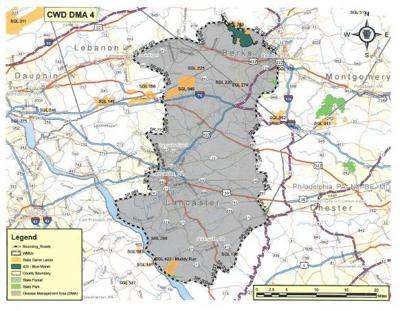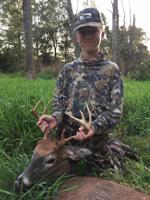A huge swath of Lancaster County is now part of a Pennsylvania Game Commission management area designed to help control the spread of chronic wasting disease among wild deer.
And that’s going to have a big impact on local hunters who chase deer in some of the county’s best hunting country.
Following the discovery last year of the always-fatal CWD in four of 33 captive deer on a farm in Upper Leacock Township, the Game Commission recently expanded CWD Disease Management Area 4 to cover more than half of Lancaster County.
DMA 4 was created in 2018 after two captive deer on a farm in West Cocalico Township were found to suffer from CWD.
At that time, the zone covered 346 square miles across parts of Lancaster, Lebanon and Berks counties. The Lancaster County area within the zone was confined to the northeast around Denver.
After the Upper Leacock discovery, DMA 4 now encompasses 743 square miles, with all the additional land sitting in Lancaster County. The zone essentially runs from Holtwood to West Cocalico Township.
Only the northwest corner and slivers of Lancaster County in the far east and extreme south are not part of DMA 4.
Chronic wasting disease is an always-fatal affliction that attacks the central nervous system of deer, elk and other cervids. There is no cure, and the only way to test an animal for it is after the animal is dead.
Since CWD was first found in a wild deer in Pennsylvania in 2012, 453 free-range deer have been found to have it across Pennsylvania. The epicenter for CWD here, however, is in a southcentral area including and surrounding Bedford County.
When the Game Commission creates a DMA, some pretty impactful rules are enacted which primarily affect hunters. Here’s a rundown of the requirements:
•You cannot remove from the zone any “high risk” parts of deer shot within DMA 4. High risk parts include anything containing brain or spine matter, the spleen and lymph nodes.
•Basically, if you take a deer to a meat processor or taxidermist, you’re going to have to do so within DMA 4. If you process your own deer and live outside DMA 4, but hunt within DMA 4, you will either have to use a local processor or process your deer within DMA 4, before taking home any meat.
•You cannot use any urine-based hunting lures or attractants.
•You cannot place out any mineral licks or food for wild deer.
Collection bins will be placed at various locations throughout DMA 4 where hunters can deposit for testing the heads of deer they shoot.
The Game Commission will test those heads and hunters can then learn if the deer they shot had CWD.
There’s no evidence that CWD can be contracted by humans eating venison from an infected deer. But the Centers for Disease Control recommends people don’t eat meat from deer that test positive for the disease.
If you’ve never hunted in a DMA before, these rules can have a big impact on your hunting experience. And while they mainly affect hunters chasing wild deer, the rules were enacted because of captive deer found on two private farms.
The Game Commission has no evidence of CWD in the wild within DMA 4.
Last year, the agency tested 469 wild deer in the original DMA 4, and none were found to have the disease.
So why impose rules that mainly affect hunters chasing wild deer when CWD was only found in six captive deer on two private farms?
“Potential exists for transmission to occur between captives and wild deer that come in contact with each other through fences, or if captives escaped even if they were later recovered,” agency staff said.
“Therefore, surveillance and precautions are necessary to determine if the wild population in that area is infected and if additional management actions are needed.
“Given the apparent low infection in this area, if CWD is detected in the local wild population, having the DMA and associated regulations in place will help the Game Commission control the disease before it becomes established on the landscape.”
And why was so much land added to the DMA around the Upper Leacock farm – especially since Upper Leacock has very little woodland?
“There are two reasons the boundary is located where it is,” agency staff said.
“First, extending the boundary to the south made it possible to place dumpsters on PGC property (At Muddy Run and State Game Lands 136) and increase opportunity for hunters to provide samples.
“Second, the larger area increases opportunities to collect adequate samples. Sample sizes will be a critical part of the decision to eliminate the DMA after 5 years if no other CWD-positive facilities or deer are detected in the DMA.”
It seems like a lot of impact on hunting caused by captive deer kept in a pen.
But the Game Commission has no authority over deer raised on farms. Those deer fall under the jurisdiction of the Pennsylvania Department of Agriculture.
The Game Commission is in discussions with the Department of Agriculture about requiring double fencing around deer farms, which would prevent wild deer outside the fence from being able to contact deer inside the fence.
Game Commission staff also said they are “trying to work in cooperation with (the department) on (a variety of) CWD related matters.”
The Game Commission has drafted a statewide plan to address CWD, which contains an array of new rules and strategies. It’s expected to be voted on by the agency’s board of directors July 25.


 P.J. REILLY | Staff Writer
P.J. REILLY | Staff Writer






